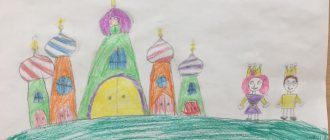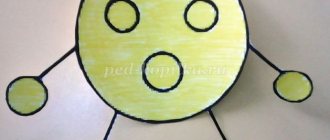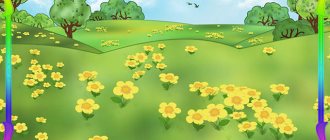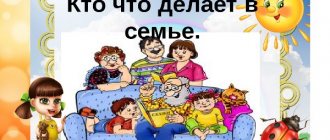Summary of a lesson on speech development junior group reading and viewing the fairy tale “The Three Bears”
Marina Kurakina
Summary of a lesson on speech development junior group reading and viewing the fairy tale “The Three Bears”
Goal: to introduce children to the Russian folk tale “The Three Bears”.
Objectives: to teach children to emotionally perceive a fairy tale, remember and
expressively reproduce words and phrases from the text intonationally.
Develop visual, auditory, tactile attention and memory; continue to develop your imagination. Foster a love of folk art.
Demo material:
Books with illustrations for every child.
Dressing children in the bedroom
.
Q : Who is this in our book corner?
Communication with children is relaxed and friendly
.
Q : What will we take to the group? Let's not go to a group, but to the forest (mysteriously, we have wolves, hares, and bears there. What else has appeared in our corner?
D : Book
Q: We haven’t read this new book yet. The tale is called "Three Bears"
Q : I have… at home. I read…
We express our joy that we found out.
Q : Would you like to read it together? Now let’s wash our hands, drink a drink and read together.
Children sit in a semicircle on the carpet. The tables are prepared in advance in a “P” formation for viewing the book. Books are prepared for each child.
Reading the fairy tale “The Three Bears”
B: Well done, all the toys have been put away, we are in order, sit down on the chairs and we will listen to a fairy tale.
Ask one of the children to bring a book from the book corner. Reading is not accompanied by showing pictures.
Q: The fairy tale is called “The Three Bears”. This fairy tale was written by Lev Nikolaevich Tolstoy. I will read, and you listen. When I read, you will sit at the tables and look at the pictures.
After reading, without asking any questions, offer to put chairs at the tables, take the book, carefully bring it to the table and put it down, sit comfortably and then start looking at it.
[/ i]Q : Look at the cover. Who's pictured there? Now look how to turn the pages (demonstration). Take a good look at the pictures.
When the majority have considered, offer to consider together.
Q : Find a picture with three bears.
Q: Show me with your finger where Mikhail Ivanovich is, where Nastasya Petrovna is, where Mishutka is? Find a picture of Mikhail Ivanovich’s table, what is it like? Find the Mishutkin table. What is he like? Show me the crib where the girl slept. Whose crib is this? Do you remember how Mishutka screamed when he saw the girl? Yes: Hold her, hold her, she screams loudly. Growl all together like bears: r-r-r-r. How the girl screamed when she saw Mishutka - a-a-a- Did the girl manage to run home? Did you like the fairy tale? Who did you like best? Why?
Q: This book will be in the book corner. You can still take a good look at it all. Now you can carefully turn the pages of the book.
Q: What fairy tale today? - Three Bears. Take the books and bring them to my table.
Q: Go to the book corner. Name the books that are there: Chicken and Three Bears. (There are pictures: dog, bear, hare)
B : Now we’ll go for a walk.
Summary of an open lesson on speech development. Reading K. Chukovsky’s fairy tale “Telephone” Summary of an open lesson on speech development. Reading K. Chukovsky’s fairy tale “Telephone” Purpose: To please children by reading a new fairy tale. Tasks:.
Summary of a lesson on speech development for children 3–4 years old based on the fairy tale “The Three Bears” Summary of a lesson with children on speech development). Lesson topic: Three bears. Objectives of the lesson: to consolidate the ability to retell a work of art.
Summary of a lesson on speech development. Reading a fairy tale in verse “Moidodyr” Purpose: To teach children to emotionally perceive a poetic work, to be aware of the theme and content; evoke a desire to remember and expressively.
Summary of a lesson on speech development. Reading the Chuvash folk tale “Wartail Mouse” Program content. To cultivate an emotional and figurative perception of the work. Learn to comprehend an idea; clarify children's knowledge about genres.
Summary of a lesson on speech development “Reading the fairy tale “Sister Alyonushka and Brother Ivanushka” Summary of a lesson on speech development on the topic: “Reading r. n. With. “Sister Alyonushka and brother Ivanushka” 1. Program content: 1. Introduce.
Lesson summary for the middle group “Let's play with bears” (based on the fairy tale “The Three Bears”) • Strengthen the ability to compare objects by size, length, width, height. Fix the idea of dividing a whole into equal geometric parts.
Speech development (junior group). Reading and dramatization of the Russian folk tale “Bull-black barrel, white hooves” Speech development (junior group) Topic: reading and dramatization of the Russian folk tale “Bull-black barrel, white hooves”. Literary quiz.
Theatrical activities in kindergarten. Reading and acting out the fairy tale “The Three Bears” In preschool age, children develop character traits, develop moral and aesthetic qualities, and develop abilities.
Lesson summary “Three Bears” (first junior group) Program content: Goal: Creating conditions for maintaining interest in the development of self-service and independence of children with elements.
Source




